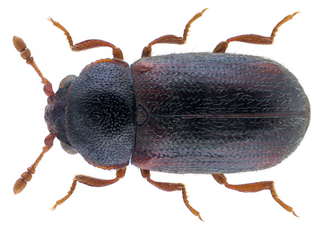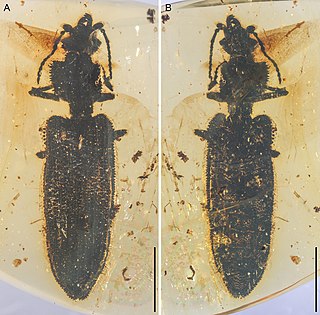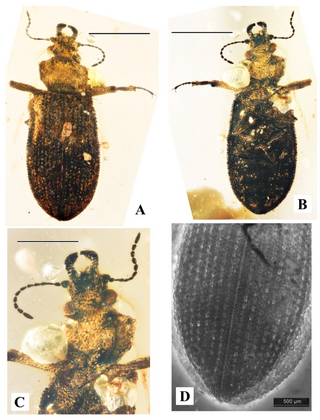
The Cupedidae are a small family of beetles, notable for the square pattern of "windows" on their elytra, which give the family their common name of reticulated beetles.

Lepicerus is a genus of myxophagan beetles containing three described species in the family Lepiceridae; it is the only extant genus in the family, with another genus, Lepiceratus only known from fossils. Extant species occur in the Neotropics, from Mexico south to Venezuela and Ecuador. Fossils referrable to the genus are known from the early Late Cretaceous of Southeast Asia.

The Ommatidae are a family of beetles in the suborder Archostemata. The Ommatidae are considered the extant beetle family that has most ancestral characteristics. There are only seven extant species, confined to Australia and South America. However, the geographical distribution was much wider during the Mesozoic spanning across Eurasia and Australia, suggesting that they were widespread on Pangea. So far, over 26 extinct genera containing over 170 species of these beetles have been described. Three extant genera have been assigned to this family: Omma,Tetraphalerus and Beutelius. The family is considered to be a subfamily of Cupedidae by some authors, but have been found to be more closely related to Micromalthidae in molecular phylogenies. A close relationship with Micromalthidae is supported by several morphological characters, including those of the mandibles and male genitalia. Due to their rarity, their ecology is obscure, it is likely that their larvae feed on deadwood.

Sphindidae is a family of beetles, in the suborder Polyphaga. They are called slime mold beetles due to their exclusive feeding on slime molds during adult and larval stages, other aspects of their life history are obscure. Palaeontological discoveries since 2015 have added to the geologic history of Sphindidae, including the discovery of Libanopsis, placed in the extinct subfamily Libanopsinae.

The Brachypsectridae are a family of beetles commonly known as the Texas beetles. There are only two extant genera, Brachypsectra and Asiopsectra. Brachypsectra has a cosmopolitan distribution, mostly in arid regions, while Asiopsectra is found in Central Asia and the Middle East.
Brochocoleus is an extinct genus of beetles in the family Ommatidae, known from the Early Jurassic to the Early Late Cretaceous. 9 species are currently recognised, with many species being reassigned to other genera by Kirejtshuk's major systematic revision in 2020.

Omma is a genus of beetles in the family Ommatidae. Omma is an example of a living fossil. The oldest species known, O. liassicum, lived during the final stage of the Triassic (Rhaetian), over 200 million years ago, though the placement of this species in Omma has been questioned. Numerous other fossil species are known from the Jurassic and Cretaceous of Europe and Asia. The only living species is Omma stanleyi, which is endemic to Australia. Three other extant species endemic to Australia that were formerly part of this genus were moved to the separate genus Beutelius in 2020.Omma stanleyi is strongly associated with wood, being found under Eucalyptus bark and exhibiting thanatosis when disturbed. Its larval stage and many other life details are unknown due to its rarity. Males are typically 14–20 mm in length, while females are 14.4-27.5 mm. Omma stanleyi occurs throughout eastern Australia from Victoria to Central Queensland.

Bukhkalius is an extinct genus of beetle belonging to the family Ommatidae, it contains the single species, Bukhkalius lindae. It was described in 2017 initially as a species of the extant genus Tetraphalerus and was placed into a separate monotypic genus in 2020, which was reaffirmed in a 2021 study. It is known from a single specimen from Burmese amber, dating to the Cenomanian stage of the Late Cretaceous. The specimen is around 4.7 mm long and around 1.3 mm wide.

Cionocups is an extinct genus of ommatid beetle. It is known from a single species, Cionocups manukyani, found in Cenomanian aged Burmese amber from Myanmar. It was originally considered to be closely related to the genus Cionocoleus, but it is considered a junior synonym of Omma by some subsequent authors.

Clessidromma is an extinct genus of ommatid beetle. It currently contains a single species Clessidromma palmeri, known from the Cenomanian aged Burmese amber of Myanmar. Kirejtshuk (2020) synonymised Lepidomma with Clessidromma and included two additional species in the latter: C. tianae, originally the type species of Lepidomma, and C. zengi, a newly described species. Li et al. (2021) disputed the synonymy of Lepidomma with Clessidromma, maintaining Lepidomma as a separate genus, and transferred C. zengi to a new genus, Kirejtomma, in 2021.
Echinocups is an extinct genus of ommatid beetle. It was created in 2020 to house three species originally assigned to Notocupes, E. denticollis, E. neli and E. ohmkuhnlei The genus name refers to the sharp spikes present on the elytra. All three species are known from the Cenomanian aged Burmese amber of Myanmar. The status of Echinocups as a distinct genus was contested by Li et al. (2023), who considered the genus Echinocups to be a junior synonym of the genus Notocupes.

Pareuryomma is an extinct genus of ommatid beetle. It is known from three species, P. angustum, P. cardiobasis and P. tylodes, all known from the Aptian aged Yixian Formation of China. The genus was first described in 2012, and formerly included the species Pareuryomma ancistrodonta from the Middle Jurassic Jiulongshan Formation, China, which was transferred to the genus Omma in 2020. The species P. angustum was formerly thought to be part of Brochocoleus. The genus is characterised by "slender body, long and subparallelsided or slightly narrowed head with moderately prominent eyes and more or less prominent temples, narrow pronotum with more or less explanate lateral carinae, elytra with the veins more or less well expressed and independently ending on Sc, large cells more or less arranged in rows on disc and moderately widely explanate sides of the elytra, and abdominal ventrites co-planar."

Polyakius is an extinct genus of archostematan beetle belonging to the family Ommatidae. It is known from two species found in Cenomanian aged Burmese amber. It is considered to be a close relative of Omma.

Paraodontomma is an extinct genus of ommatid beetle, it is known from three species, P. burmiticum described in 2017, P. szwedoi described in 2018. and P. leptocristatum in 2021. All 3 species are known from the Cenomanian aged Burmese amber.
Stegocoleus is an extinct genus of ommatid beetle. Its distinctive morphology includes a distinctive flat rim on the outer edge of the elytra similar to those of Burmocoleus and Jarzembowskiops, but is distinguished from those genera by a distinctive prothorax. It is known from 3 species found in Cenomanian aged Burmese amber.
Jarzembowskiops is an extinct genus of ommatid beetle. It is known from one species, J. caseyi described from the Cenomanian aged Burmese amber of Myanmar. It was originally placed as a species of Brochocoleus, but was subsequently considered distinct enough to warrant its placement in its own separate genus. The species is named after Raymond Casey, a British geologist, while the genus is named after Edmund Jarzembowski, a noted British palaeoentomologist.
Burmese amber is fossil resin dating to the early Late Cretaceous Cenomanian age recovered from deposits in the Hukawng Valley of northern Myanmar. It is known for being one of the most diverse Cretaceous age amber paleobiotas, containing rich arthropod fossils, along with uncommon vertebrate fossils and even rare marine inclusions. A mostly complete list of all taxa described up until 2018 can be found in Ross 2018; its supplement Ross 2019b covers most of 2019.

Kirejtomma is an extinct genus of ommatid beetle, known from the early Late Cretaceous (Cenomanian) aged Burmese amber of Myanmar. The type and only known species K. zhengi was described in 2020 as a species of Clessidromma, and placed into the new genus in 2021.
Lepidomma is an extinct genus of ommatid beetle. The genus was first described in 2019 for the species L. tianae. Lepidomma was synonymised with Clessidromma by Kirejtshuk, 2020. This synonymy was disputed by Li et al. (2021), who maintained Lepidomma as a separate genus from Clessidromma. Three additional species of Lepidomma were described in 2020 and 2022. All four species are known from the Cenomanian aged Burmese amber of Myanmar.

Notocupes is an extinct genus of medium-sized archostematan beetles from the Mesozoic Era of Eurasia, including over 50 described species. Historically, the genus was classified as a member of the family Ommatidae, but the presence of characters such as the horizontal mandibular cutting edge, separated procoxae and overlapping abdominal sternites indicate that the genus may have a closer affinity with the family Cupedidae. Notocupes is considered to be a junior synonym of Zygadenia by Kirejtshuk (2020), but other researchers suggest to reserve the genus Zygadenia as a form taxon for isolated elytra that probably belong to the genus Notocupes, while retaining Notocupes as a valid genus for complete body fossils. Most species of Notocupes were described from compression fossils. An additional three species were described from Cenomanian-aged Burmese amber, which were treated as a separate genus, Echinocups, by Kirejtshuk (2020), but Li et al. (2023) consider Echinocups to be a junior synonym of Notocupes. Notocupes has a flattened body, which may suggest that it occupied narrow habitats, such as living under bark. Some species had serrated/spined margins of the carapace, which may have served as a defense against predators, or served as camouflage to resemble bark.














